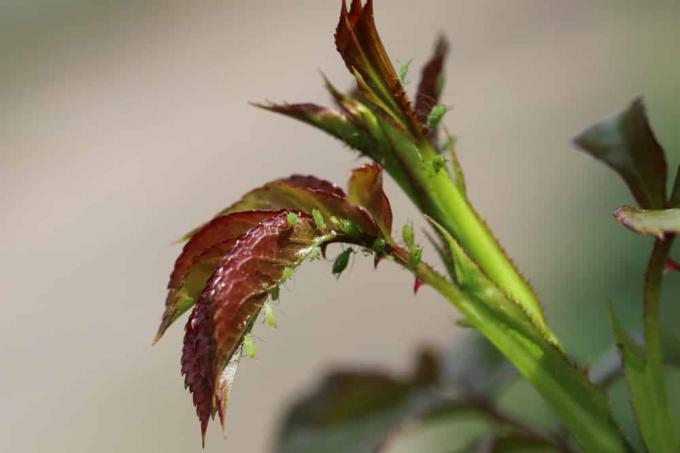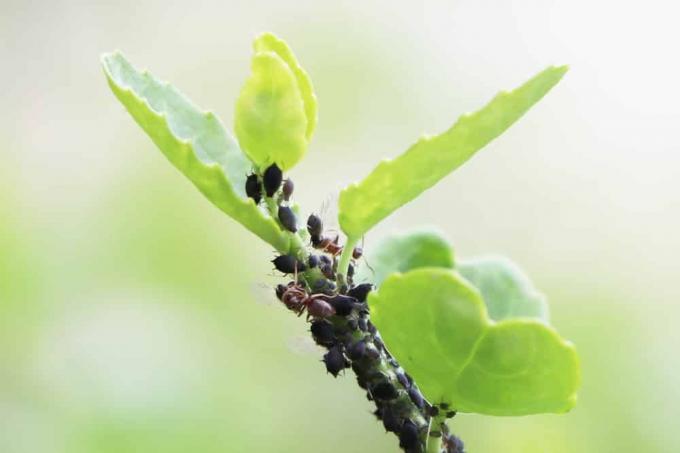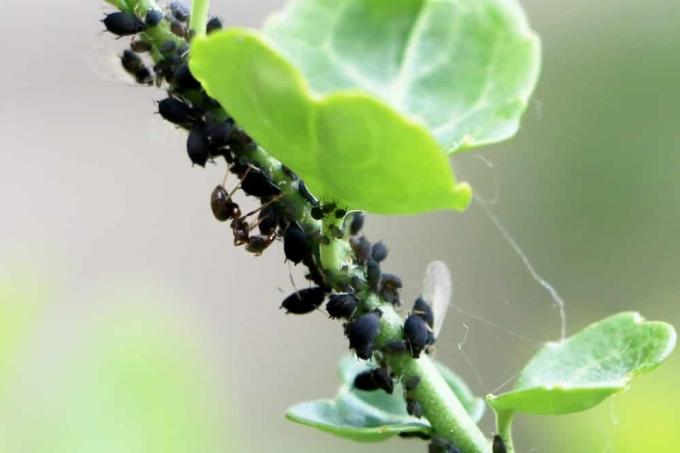

Table of contents
- Fight aphids successfully - preliminary considerations
- First measure: spraying the plant
- Mechanical collection with low infestation
- For winged lice: Use of yellow stickers
- For edible plants: control with nettle broth
- Biological agents: Oil-based solutions
- Inexpensive pest control: potash soap solution
- Chemical agents for stubborn infestation
Widespread, feared and repeatedly fought with strong weapons - aphids are among the most unpopular pests of the hobby gardener. The green, grey, brown or yellow suckers, which grow between three and seven centimetres, love the sap of certain local plants. Persistent infestation eventually leads to honeydew excretion, stunted shoot tips and stunted flowers. In order to be able to successfully combat the annoying pests that primarily attack weak and diseased plants, there are numerous effective means available.
Fight aphids successfully - preliminary considerations
The choice of a suitable remedy against aphids should always be made very carefully, as certain initial criteria must be observed. This includes the following questions:
- Is it a year-round or temporary houseplant?
- Should a decorative houseplant or a pleasure plant be treated?
- How far has the infestation progressed?
The question of location is particularly important; Above all, plants that are on the balcony or terrace during the warm season and are only brought into the house in the winter months carry a high risk. Getting used to the climatic conditions in the house makes the plant more vulnerable and weaker. In addition, dry heating air and the proximity to other plants ensure a higher risk and good conditions for aphids. If the plant is already infested by a few specimens, the lice will also spread explosively in the new environment.
Therefore:
Before moving an outdoor plant to its winter quarters, the individual leaves and shoots must be carefully examined. If necessary, the plant should be left outdoors for a few more days to combat smaller aphid populations. Before moving, the plant must be pest-free. It is also important to consider whether it is an ornamental or a pleasure plant, because houseplants also include some species that produce fruit or edible leaves.
These include, for example:
- Various types of chili (especially Siberian house pepper)
- lemon or tangerine trees
- lemon herb
- Stevia
If it is an edible houseplant, the treatment may only be carried out with the help of mechanical control (e.g. B. collecting the lice, using yellow stickers) or by using biological means. For all other indoor plants, however, chemical preparations may also be used. In the greenhouse and outdoors, the use of certain beneficial insects (e.g. ladybugs) is not recommended in the house; the propagation of such species is hardly possible in closed rooms, so that beneficial insects are mainly used in greenhouses or outdoors.
First measure: spraying the plant
If the aphid infestation is still in the early stages, it is often sufficient to treat the plant with water; the water jet causes the aphids to fall off the plant. If the plants are small, the affected parts of the plant can be sprayed with water. Larger specimens are best placed in the shower and rinsed off thoroughly. It's good practice to hold the plant at an angle and spray the leaves from different angles, focusing on reaching the undersides and axils of the leaves; experience has shown that this is where most of the pests reside. To protect the soil, a plastic bag is placed on the substrate and placed over the pot.

Caution:
Not every plant is suitable for rinsing off in the shower; filigree plants with delicate leaves in particular can easily be damaged by this treatment.
Mechanical collection with low infestation
If only a few aphids appear on the plant, they can also be removed with the help of mechanical treatment:
- easy collection
- Wipe off with a brush
- Treatment with a hair dryer
When treating with a hair dryer, hold it at an angle; the lice are blown off the leaves by the hot air or jump off the plant. Caution: It is essential to ensure that there is a sufficient safety distance between the hair dryer and the plant; the hot air could damage the leaves of the crops. It is also important to remember that this measure does not kill the aphids. It has therefore proven useful to remove neighboring plants from the window sill before combating it.
For winged lice: Use of yellow stickers
When fighting aphids, it is often not possible to completely clear the window sill and remove all neighboring plants. Yellow stickers can be used to protect neighboring plants. Above all, winged variants of the lice stick to the plaques and thus prevent further spread. But even wingless specimens are attracted by the yellow color of the stickers - provided they are within reach. The pests stick to the yellow stickers and die.
For edible plants: control with nettle broth
If it is an ornamental plant that contains edible parts, it has proven useful to use plant-based products to combat aphids. Nettle decoction, which can be prepared according to the following recipe, is particularly effective in this context:
- 1. 100g nettles are mixed with one liter of water.
- 2. The mixture is boiled and then cooled again.
- 3. The leaves are left in the water for 2 days.
- 4. The nettles are then passed through a sieve.
- 5. The brew is poured into a squeeze bottle.
The plant is sprayed with the solution until it is dripping wet. The ingredients of the nettle not only drive away the aphids, but also strengthen the plant's defences. To increase the effect, fresh leaves should always be used.
Tip:
The production of nettle stock is accompanied by a strong odor nuisance. It has therefore proven useful to produce them outdoors.
Biological agents: Oil-based solutions
If the aphid infestation is severe, the plant can be treated with oil-based spray solutions. The rapeseed or neem oil often used for this covers the pests with an oil film and then allows them to suffocate. To prepare the oil solution, a total of five liters of water are mixed with 90ml of the selected oil; the solution is then placed in a squeeze bottle.

When treating the plant, it is important to ensure that all areas on the underside of the leaves are carefully wetted - because this is where most lice are located. When using it, it should also be remembered that oil preparations act primarily against the pest larvae. The effect is therefore delayed and the application must be repeated. In addition, the following information should be observed during use:
- Treatment is best done outdoors.
- Especially thick-leaved plants benefit from the application.
- Thin-leaved plants tend to stick together, so use carefully
- If the plant is used on a large area, then rinse it off
Inexpensive pest control: potash soap solution
One of the classic anti-aphid remedies is the typical soap solution, which is particularly inexpensive to produce. Both unperfumed curd soaps and soft soaps without additives are used. Experts, on the other hand, advise against using classic soaps with synthetic ingredients, as these can damage the plants.
For the preparation of the soap solution, the hobby gardener takes a liter of water to which a tablespoon of soft soap is added. A dash of alcohol helps to increase the effect. The finished solution is then filled into a squeeze bottle and then administered. The growth must be carefully covered before treatment; the solution should never get into the ground. A plastic bag slipped over the edge of the substrate offers protection here. After administering the solution, the following points should be observed:
- Allow the solution to dry thoroughly
- Place the plant in a bright spot for two to three days
- Use water to rid leaves of dead pests
- constant pest control in the following days
- possible renewed use of the soap solution
Chemical agents for stubborn infestation
If the plant to be treated is purely an ornamental plant, chemical agents can also be used to combat it. Plant protection products based on pyrethrum are among the classics in this context; it is a powerful pest control agent, but it breaks down in a short time. As a typical contact poison, the substance only has an external effect on the pest - and is not absorbed by the plant. In this way, damage to the crop can be minimized.

To combat the aphids, the hobby gardener wets the affected parts of the plant with the contact poison. Even if no lice are visible on the upper side, they must also be treated - sometimes the eggs are not easy to see. The following aspects must also be taken into account when using pyrethrum:
- gloves must be worn during application
- Pay close attention to dosage
- Repeat application after 7-9 days
It doesn't matter which pesticide you choose - it is important to have good stamina when fighting aphids. These are extraordinarily stubborn pests that keep coming back and also adapt to changing circumstances. But if you examine your plants regularly and take countermeasures at the slightest infestation, you will get the infestation under control with the means mentioned.
 garden editorial
garden editorial I write about everything that interests me in my garden.
Learn more about aphids

Garlic against aphids: make garlic stock
Aphids usually appear overnight and quickly become a real nuisance. A proven home remedy for lice is garlic broth. The production of the biological crop protection product, which can be used indoors and outdoors, is easy.

Effectively combat aphids on lavender & jasmine
Effective home remedies have even been developed to combat stubborn plant pests. This guide explains how gardeners can rid their jasmine or lavender of lice with inexpensive and environmentally friendly treatments.

Aphid profile: size, food, control
Aphids are among the biggest enemies of every gardener along with snails. In Europe alone there are several hundred species that have fruit, vegetables and ornamental plants as a food source. Some species can be driven away with home remedies that are non-toxic to nature.

Prevent aphids | 6 home remedies to get rid of aphids
Anyone who manages a garden, maintains flower boxes or even has potted plants on their windowsill at home knows them - the aphids. You can find out here how you can avoid the influx of annoying visitors from the outset using simple home remedies.

Fighting lice on raspberries | 13 natural remedies against aphids
Raspberries taste best straight from the bush. However, for a good yield, the fruits and shrubs should be healthy and free from pests. You should do something against aphids in the spring, long before the fruit ripens.

Fight aphids on herbs biologically | 10 home remedies & beneficial insects
Aphids are unwelcome guests in the garden and like to spread on the tasty herbs. Unfortunately, these plants are very sensitive and suffer greatly from pest infestation, which can even lead to their death. As an antidote, biological alternatives to the chemical club are always to be preferred.

